Zhengyia shennongensis-- A new bulbiliferous genus and species of Urticaceae from central China
- 格式:pdf
- 大小:6.81 MB
- 文档页数:11
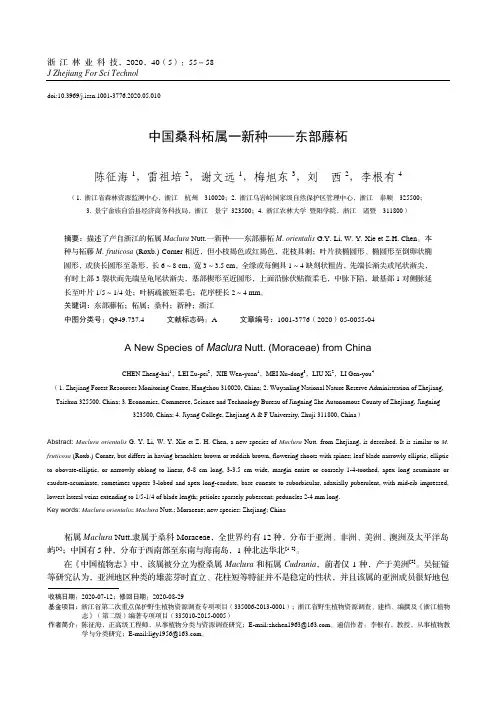
浙江林业科技,2020,40(5):55-58J Zhejiang For Sci Technoldoi:10.3969/j.issn.1001-3776.2020.05.010中国桑科柘属一新种——东部藤柘陈征海1,雷祖培2,谢文远1,梅旭东3,刘西2,李根有4(1. 浙江省森林资源监测中心,浙江杭州 310020;2. 浙江乌岩岭国家级自然保护区管理中心,浙江泰顺 325500;3. 景宁畲族自治县经济商务科技局,浙江景宁 323500;4. 浙江农林大学暨阳学院,浙江诸暨 311800)摘要:描述了产自浙江的柘属Maclura Nutt.一新种——东部藤柘M. orientalis G.Y. Li, W. Y. Xie et Z.H. Chen。
本种与柘藤M. fruticosa (Roxb.) Corner相近,但小枝褐色或红褐色,花枝具刺;叶片狭椭圆形、椭圆形至倒卵状椭圆形,或狭长圆形至条形,长6 ~ 8 cm,宽3 ~ 3.5 cm,全缘或每侧具1 ~ 4缺刻状粗齿,先端长渐尖或尾状渐尖,有时上部3裂状而先端呈龟尾状渐尖,基部楔形至近圆形,上面沿脉伏贴微柔毛,中脉下陷,最基部1对侧脉延长至叶片1/5 ~ 1/4处;叶柄疏被短柔毛;花序梗长2 ~ 4 mm。
关键词:东部藤柘;柘属;桑科;新种;浙江中图分类号:Q949.737.4 文献标志码:A 文章编号:1001-3776(2020)05-0055-04A New Species of Maclura Nutt. (Moraceae) from ChinaCHEN Zheng-hai1,LEI Zu-pei2,XIE Wen-yuan1,MEI Xu-dong3,LIU Xi2,LI Gen-you4(1. Zhejiang Forest Resources Monitoring Centre, Hangzhou 310020, China; 2. Wuyanling National Nature Reserve Administration of Zhejiang, Taishun 325500, China; 3. Economics, Commerce, Science and Technology Bureau of Jingning She Autonomous County of Zhejiang, Jingning 323500, China; 4. Jiyang College, Zhejiang A & F University, Zhuji 311800, China)Abstract:Maclura orientalis G. Y. Li, W. Y. Xie et Z. H. Chen, a new species of Maclura Nutt. from Zhejiang, is described. It is similar to M. fruticosa (Roxb.) Corner, but differs in having branchlets brown or reddish brown, flowering shoots with spines; leaf blade narrowly elliptic, elliptic to obovate-elliptic, or narrowly oblong to linear, 6-8 cm long, 3-3.5 cm wide, margin entire or coarsely 1-4-toothed, apex long acuminate or caudate-acuminate, sometimes uppers 3-lobed and apex long-caudate, base cuneate to suborbicular, adaxially puberulent, with mid-rib impressed, lowest lateral veins extending to 1/5-1/4 of blade length; petioles sparsely pubescent; peduncles 2-4 mm long.Key words:Maclura orientalis; Maclura Nutt.; Moraceae; new species; Zhejiang; China柘属Maclura Nutt.隶属于桑科Moraceae,全世界约有12种,分布于亚洲、非洲、美洲、澳洲及太平洋岛屿[1];中国有5种,分布于西南部至东南与海南岛,1种北达华北[1-2]。
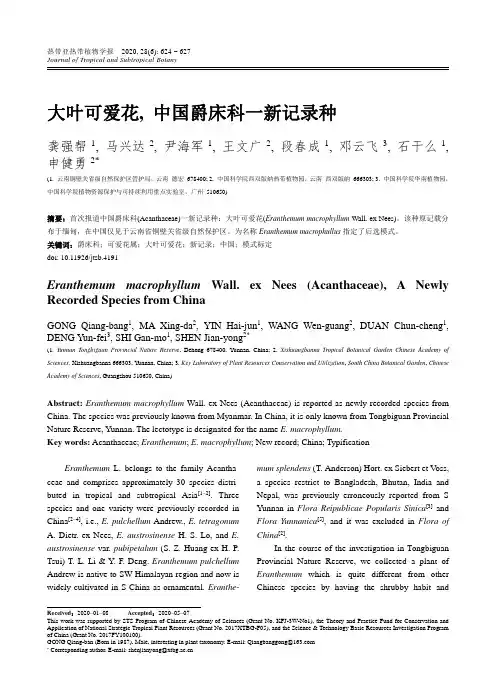
热带亚热带植物学报 2020, 28(6): 624 ~ 627 Journal of Tropical and Subtropical BotanyReceived :2020–01–08 Accepted :2020–05–07This work was supported by STS Program of Chinese Academy of Sciences (Grant No. KFJ-3W-No1), the Theory and Practice Fund for Conservation and Application of National Strategic Tropical Plant Resources (Grant No. 2017XTBG-F05), and the Science & Technology Basic Resources Investigation Program of China (Grant No. 2017FY100100).GONGQiang-ban(Bornin1987),Male,interestinginplanttaxonomy.E-mail:********************* ∗Correspondingauthor.E-mail:********************.cn大叶可爱花, 中国爵床科一新记录种龚强帮1, 马兴达2, 尹海军1, 王文广2, 段春成1, 邓云飞3, 石干么1, 申健勇2*(1. 云南铜壁关省级自然保护区管护局,云南 德宏 678400; 2. 中国科学院西双版纳热带植物园,云南 西双版纳 666303; 3. 中国科学院华南植物园,中国科学院植物资源保护与可持续利用重点实验室,广州 510650)摘要:首次报道中国爵床科(Acanthaceae)一新记录种:大叶可爱花(Eranthemum macrophyllum Wall. ex Nees)。
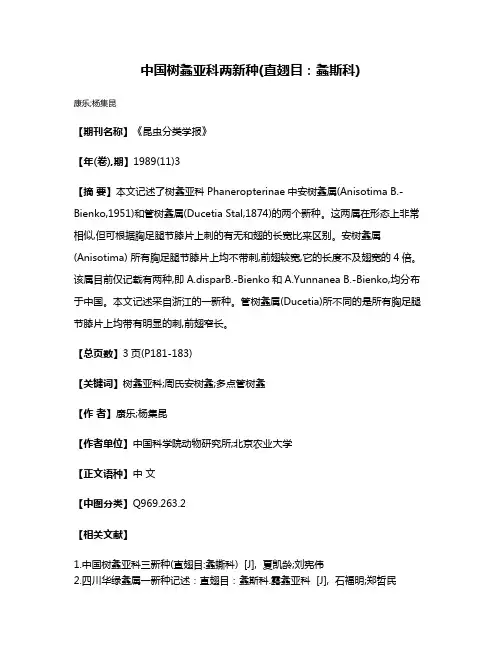
中国树螽亚科两新种(直翅目:螽斯科)
康乐;杨集昆
【期刊名称】《昆虫分类学报》
【年(卷),期】1989(11)3
【摘要】本文记述了树螽亚科Phaneropterinae中安树螽属(Anisotima B.-Bienko,1951)和管树螽属(Ducetia Stal,1874)的两个新种。
这两属在形态上非常相似,但可根据胸足腿节膝片上刺的有无和翅的长宽比来区别。
安树螽属(Anisotima) 所有胸足腿节膝片上均不带刺,前翅较宽,它的长度不及翅宽的4倍。
该属目前仅记载有两种,即A.disparB.-Bienko和A.Yunnanea B.-Bienko,均分布于中国。
本文记述采自浙江的一新种。
管树螽属(Ducetia)所不同的是所有胸足腿节膝片上均带有明显的刺,前翅窄长。
【总页数】3页(P181-183)
【关键词】树螽亚科;周氏安树螽;多点管树螽
【作者】康乐;杨集昆
【作者单位】中国科学院动物研究所;北京农业大学
【正文语种】中文
【中图分类】Q969.263.2
【相关文献】
1.中国树螽亚科三新种(直翅目:螽蟖科) [J], 夏凯龄;刘宪伟
2.四川华绿螽属一新种记述:直翅目:螽斯科.露螽亚科 [J], 石福明;郑哲民
3.中国平背树螽属两新种(直翅目:螽斯科:树螽亚科) [J], 杨集昆;康东
4.中国剑螽属一新种记述:直翅目:螽斯科:蛩螽亚科 [J], 石福明;郑哲民
5.中国平脉树螽属五新种记述:直翅目:螽斯科:树螽亚科 [J], 康乐;杨集昆因版权原因,仅展示原文概要,查看原文内容请购买。
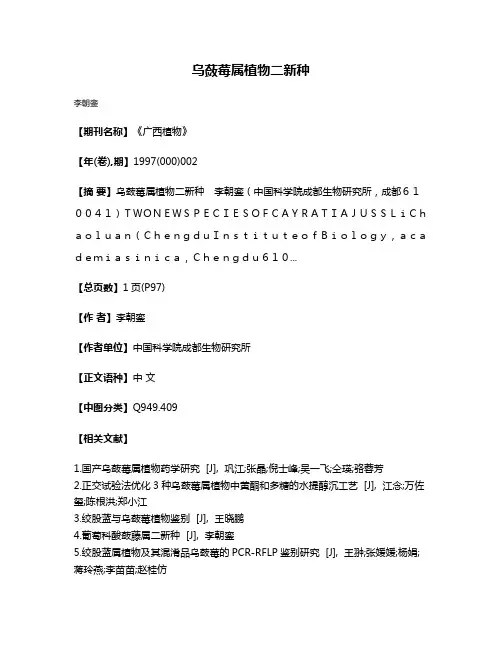
乌蔹莓属植物二新种
李朝銮
【期刊名称】《广西植物》
【年(卷),期】1997(000)002
【摘 要】乌蔹莓属植物二新种李朝銮(中国科学院成都生物研究所,成都61
0041)TWONEWSPECIESOFCAYRATIAJUSSLiCh
aoluan(ChengduInstituteofBiology,aca
demiasinica,Chengdu610...
【总页数】1页(P97)
【作 者】李朝銮
【作者单位】中国科学院成都生物研究所
【正文语种】中 文
【中图分类】Q949.409
【相关文献】
1.国产乌蔹莓属植物药学研究 [J], 巩江;张晶;倪士峰;吴一飞;仝瑛;骆蓉芳
2.正交试验法优化3种乌蔹莓属植物中黄酮和多糖的水提醇沉工艺 [J], 江念;万佐
玺;陈根洪;郑小江
3.绞股蓝与乌蔹莓植物鉴别 [J], 王晓鹏
4.葡萄科酸蔹藤属二新种 [J], 李朝銮
5.绞股蓝属植物及其混淆品乌蔹莓的PCR-RFLP鉴别研究 [J], 王翀;张媛媛;杨娟;
蒋玲燕;李苗苗;赵桂仿
因版权原因,仅展示原文概要,查看原文内容请购买
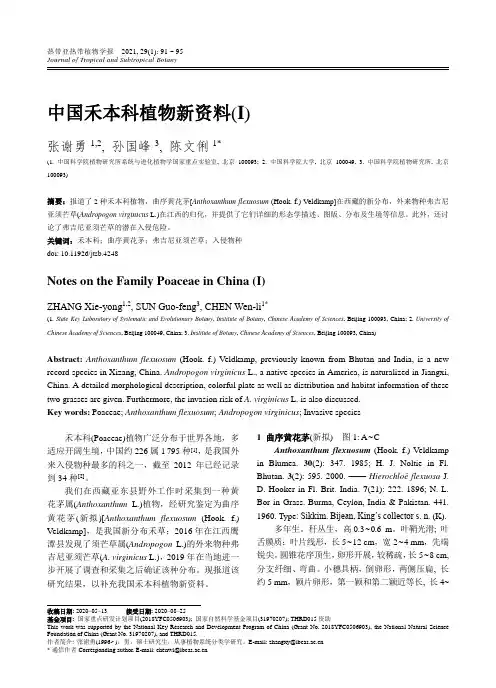
热带亚热带植物学报 2021, 29(1): 91 ~ 95 Journal of Tropical and Subtropical Botany收稿日期: 2020–05–13 接受日期: 2020–08–25基金项目: 国家重点研发计划项目(2018YFC0506903); 国家自然科学基金项目(31970207); THRD015资助This work was supported by the National Key Research and Development Program of China (Grant No. 2018YFC0506903), the National Natural Science Foundation of China (Grant No. 31970207), and THRD015.作者简介: 张谢勇(1996~ ),男,硕士研究生,从事植物系统分类学研究。
E-mail:****************.cn * 通信作者Correspondingauthor.E-mail:***************.cn中国禾本科植物新资料(I )张谢勇1,2, 孙国峰3, 陈文俐1*(1. 中国科学院植物研究所系统与进化植物学国家重点实验室, 北京 100093; 2. 中国科学院大学, 北京 100049, 3. 中国科学院植物研究所, 北京100093)摘要:报道了2种禾本科植物,曲序黄花茅[Anthoxanthum flexuosum (Hook. f.) Veldkamp]在西藏的新分布,外来物种弗吉尼亚须芒草(Andropogon virginicus L.)在江西的归化,并提供了它们详细的形态学描述、图版、分布及生境等信息。
此外,还讨论了弗吉尼亚须芒草的潜在入侵危险。
关键词:禾本科;曲序黄花茅;弗吉尼亚须芒草;入侵物种 doi: 10.11926/jtsb.4248Notes on the Family Poaceae in China (I)ZHANG Xie-yong 1,2, SUN Guo-feng 3, CHEN Wen-li 1*(1. State Key Laboratory of Systematic and Evolutionary Botany , Institute of Botany , Chinese Academy of Sciences , Beijing 100093, China; 2. University of Chinese Academy of Sciences , Beijing 100049, China; 3. Institute of Botany , Chinese Academy of Sciences , Beijing 100093, China)Abstract: Anthoxanthum flexuosum (Hook. f.) Veldkamp, previously known from Bhutan and India, is a new record species in Xizang, China. Andropogon virginicus L., a native species in America, is naturalized in Jiangxi, China. A detailed morphological description, colorful plate as well as distribution and habitat information of these two grasses are given. Furthermore, the invasion risk of A. virginicus L. is also discussed.Key words: Poaceae; Anthoxanthum flexuosum ; Andropogon virginicus ; Invasive species禾本科(Poaceae)植物广泛分布于世界各地,多适应开阔生境,中国约226属1 795种[1],是我国外来入侵物种最多的科之一,截至2012年已经记录到34种[2]。
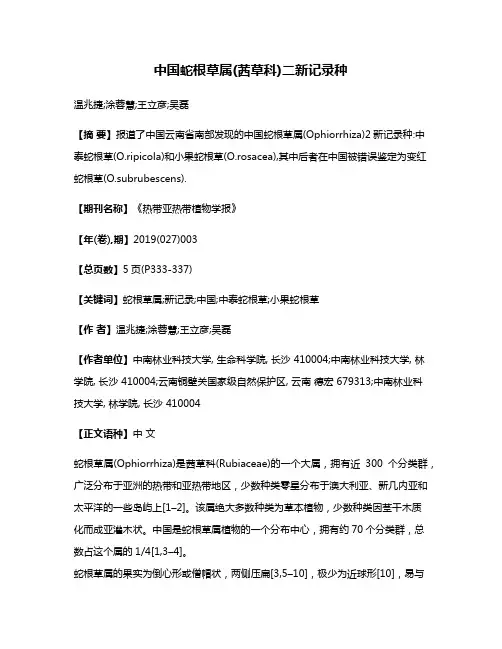
中国蛇根草属(茜草科)二新记录种温兆捷;涂蓉慧;王立彦;吴磊【摘要】报道了中国云南省南部发现的中国蛇根草属(Ophiorrhiza)2新记录种:中泰蛇根草(O.ripicola)和小果蛇根草(O.rosacea),其中后者在中国被错误鉴定为变红蛇根草(O.subrubescens).【期刊名称】《热带亚热带植物学报》【年(卷),期】2019(027)003【总页数】5页(P333-337)【关键词】蛇根草属;新记录;中国;中泰蛇根草;小果蛇根草【作者】温兆捷;涂蓉慧;王立彦;吴磊【作者单位】中南林业科技大学, 生命科学院, 长沙 410004;中南林业科技大学, 林学院, 长沙 410004;云南铜壁关国家级自然保护区, 云南德宏 679313;中南林业科技大学, 林学院, 长沙 410004【正文语种】中文蛇根草属(Ophiorrhiza)是茜草科(Rubiaceae)的一个大属,拥有近300个分类群,广泛分布于亚洲的热带和亚热带地区,少数种类零星分布于澳大利亚、新几内亚和太平洋的一些岛屿上[1–2]。
该属绝大多数种类为草本植物,少数种类因茎干木质化而成亚灌木状。
中国是蛇根草属植物的一个分布中心,拥有约70个分类群,总数占这个属的1/4[1,3–4]。
蛇根草属的果实为倒心形或僧帽状,两侧压扁[3,5–10],极少为近球形[10],易与其他属植物区别。
虽如此,该属植物在不同地区的形态特征差异很大[10],加之多数种类形态描述十分不足[11],以致关于该属的较为系统的研究到目前为止仅在太平洋岛屿[10]、中国[3]和印度[9]三个地区有过开展。
在标本研究和野外调查中,作者发现采自中国云南的2种蛇根草属植物比较特别,不同于目前中国已记载的蛇根草属种类。
进一步查阅相关文献[1,3,12–15]和研究标本,最终确定该2种蛇根草属植物实为中国的新记录种: 中泰蛇根草(O. ripicola) 和小果蛇根草(O.rosacea)。
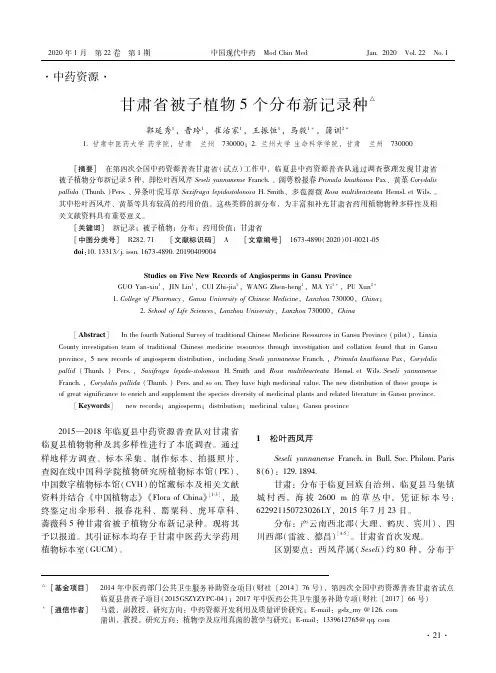
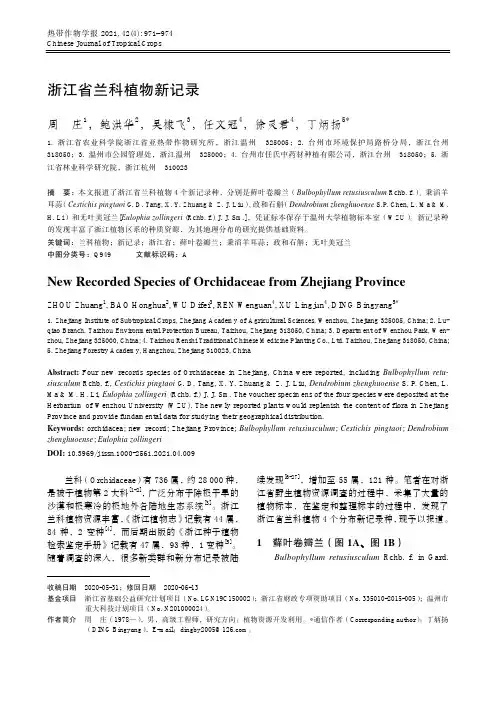
热带作物学报2021, 42(4): 971 974 Chinese Journal of Tropical Crops收稿日期 2020-05-31;修回日期 2020-06-13基金项目 浙江省基础公益研究计划项目(No. LGN19C150002);浙江省财政专项资助项目(No. 335010-2015-005);温州市重大科技计划项目(No. N201000024)。
作者简介 周 庄(1978—),男,高级工程师,研究方向:植物资源开发利用。
*通信作者(Corresponding author ):丁炳扬(DING Bingyang ),E-mail :******************。
浙江省兰科植物新记录周 庄1,鲍洪华2,吴棣飞3,任文冠4,徐灵君4,丁炳扬5*1. 浙江省农业科学院浙江省亚热带作物研究所,浙江温州 325005;2. 台州市环境保护局路桥分局,浙江台州 318050;3. 温州市公园管理处,浙江温州 325000;4. 台州市任氏中药材种植有限公司,浙江台州 318050;5. 浙江省林业科学研究院,浙江杭州 310023摘 要:本文报道了浙江省兰科植物4个新记录种,分别是藓叶卷瓣兰(Bulbophyllum retusiusculum Rchb. f.)、秉滔羊耳蒜(Cestichis pingtaoi G. D. Tang, X. Y. Zhuang & Z. J. Liu )、政和石斛(Dendrobium zhenghuoense S.P. Chen, L. Ma & M. H. Li )和无叶美冠兰[Eulophia zollingeri (Rchb. f.) J. J. Sm.],凭证标本保存于温州大学植物标本室(WZU )。
新记录种的发现丰富了浙江植物区系的种质资源,为其地理分布的研究提供基础资料。
关键词:兰科植物;新记录;浙江省;藓叶卷瓣兰;秉滔羊耳蒜;政和石斛;无叶美冠兰 中图分类号:Q949 文献标识码:ANew Recorded Species of Orchidaceae from Zhejiang ProvinceZHOU Zhuang 1, BAO Honghua 2, WU Difei 3, REN Wenguan 4, XU Lingjun 4, DING Bingyang 5*1. Zhejiang Institute of Subtropical Crops, Zhejiang Academy of Agricultural Sciences, Wenzhou, Zhejiang 325005, China;2. Lu-qiao Branch, Taizhou Environmental Protection Bureau, Taizhou, Zhejiang 318050, China;3. Department of Wenzhou Park, Wen-zhou, Zhejiang 325000, China;4. Taizhou Renshi Traditional Chinese Medicine Planting Co., Ltd. Taizhou, Zhejiang 318050, China;5. Zhejiang Forestry Academy, Hangzhou, Zhejiang 310023, ChinaAbstract: Four new records species of Orchidaceae in Zhejiang, China were reported, including Bulbophyllum retu-siusculum Rchb. f., Cestichis pingtaoi G. D. Tang, X. Y. Zhuang & Z. J. Liu, Dendrobium zhenghuoense S. P. Chen, L. Ma & M. H. Li, Eulophia zollingeri (Rchb. f.) J. J. Sm. The voucher specimens of the four species were deposited at the Herbarium of Wenzhou University (WZU). The newly reported plants would replenish the content of flora in Zhejiang Province and provide fundamental data for studying their geographical distribution.Keywords: orchidacea; new record; Zhejiang Province; Bulbophyllum retusiusculum ; Cestichis pingtaoi ; Dendrobium zhenghuoense ; Eulophia zollingeriDOI: 10.3969/j.issn.1000-2561.2021.04.009兰科(Orchidaceae )有736属,约28 000种,是被子植物第2大科[1-2],广泛分布于除极干旱的沙漠和极寒冷的极地外各陆地生态系统[3]。
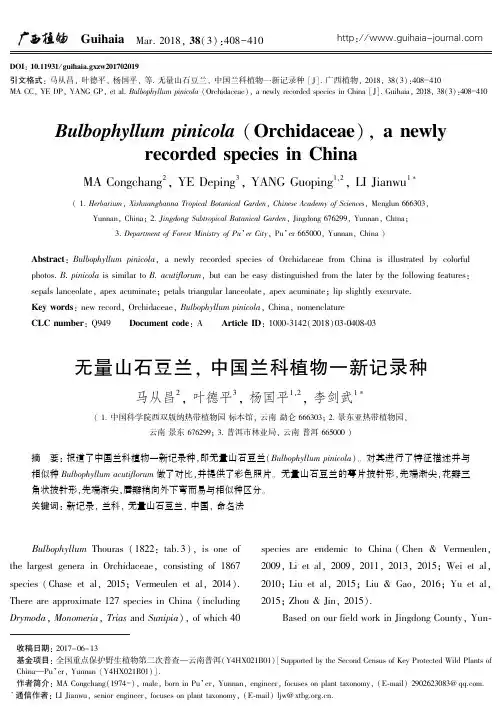
㊀Guihaia㊀Mar.2018,38(3):408-410http://www.guihaia-journal.comDOI:10.11931/guihaia.gxzw201702019引文格式:马从昌,叶德平,杨国平,等.无量山石豆兰,中国兰科植物一新记录种[J].广西植物,2018,38(3):408-410MACC,YEDP,YANGGP,etal.Bulbophyllumpinicola(Orchidaceae),anewlyrecordedspeciesinChina[J].Guihaia,2018,38(3):408-410Bulbophyllumpinicola(Orchidaceae),anewlyrecordedspeciesinChinaMACongchang2,YEDeping3,YANGGuoping1,2,LIJianwu1∗(1.Herbarium,XishuangbannaTropicalBotanicalGarden,ChineseAcademyofSciences,Menglun666303,Yunnan,China;2.JingdongSubtropicalBatanicalGarden,Jingdong676299,Yunnan,China;3.DepartmentofForestMinistryofPu erCity,Pu er665000,Yunnan,China)Abstract:Bulbophyllumpinicola,anewlyrecordedspeciesofOrchidaceaefromChinaisillustratedbycolorfulphotos.B.pinicolaissimilartoB.acutiflorum,butcanbeeasydistinguishedfromthelaterbythefollowingfeatures:sepalslanceolate,apexacuminate;petalstriangularlanceolate,apexacuminate;lipslightlyexcurvate.Keywords:newrecord,Orchidaceae,Bulbophyllumpinicola,China,nomenclatureCLCnumber:Q949㊀㊀Documentcode:A㊀㊀ArticleID:1000⁃3142(2018)03⁃0408⁃03无量山石豆兰,中国兰科植物一新记录种马从昌2,叶德平3,杨国平1,2,李剑武1∗(1.中国科学院西双版纳热带植物园标本馆,云南勐仑666303;2.景东亚热带植物园,云南景东676299;3.普洱市林业局,云南普洱665000)摘㊀要:报道了中国兰科植物一新记录种,即无量山石豆兰(Bulbophyllumpinicola)㊂对其进行了特征描述并与相似种Bulbophyllumacutiflorum做了对比,并提供了彩色照片㊂无量山石豆兰的萼片披针形,先端渐尖,花瓣三角状披针形,先端渐尖,唇瓣稍向外下弯而易与相似种区分㊂关键词:新记录,兰科,无量山石豆兰,中国,命名法㊀㊀BulbophyllumThouras(1822:tab.3),isoneofthelargestgenerainOrchidaceae,consistingof1867species(Chaseetal,2015;Vermeulenetal,2014).Thereareapproximate127speciesinChina(includingDrymoda,Monomeria,TriasandSunipia),ofwhich40speciesareendemictoChina(Chen&Vermeulen,2009,Lietal,2009,2011,2013,2015;Weietal,2010;Liuetal,2015;Liu&Gao,2016;Yuetal,2015;Zhou&Jin,2015).BasedonourfieldworkinJingdongCounty,Yun⁃收稿日期:2017-06-13基金项目:全国重点保护野生植物第二次普查 云南普洱(Y4HX021B01)[SupportedbytheSecondCensusofKeyProtectedWildPlantsofChina Pu er,Yunnan(Y4HX021B01)].作者简介:MACongchang(1974-),male,borninPu er,Yunnan,engineer,focusesonplanttaxonomy,(E⁃mail)2902623083@qq.com.∗通信作者:LIJianwu,seniorengineer,focusesonplanttaxonomy,(E⁃mail)ljw@xtbg.org.cn.Note:A.Habitat;B.Inflorescence;C.Pedicelandovarywithcolumnandlip;D.Flower(a.Dorsalsepal,b.Lateralsepals,c.Petals,d.Pedicelandovarywithcolumnandlip,e.Floralbract);E.Flower(faceview).Fig.1㊀Bulbophyllumpinicola(EditedbyLIJianwu,photographedbyYEDeping)㊀nanProvince,Chinaduring2014 2016,anewrecordofBulbophyllumwasfoundandnowreportedhere.BulbophyllumpinicolaGagnep.,Bull.Mus.Natl.Hist.Nat.,sér.II.ii:146.1930. Bulbo⁃phyllumpinicolumGagnep.Bulbophyllumpinicola(Fig.1)Epiphytic.Rhizomecreeping,ca.2mmindiam.;pseudobulbs1.0-1.5cmapartfromeachotheralongtherhizome,subglobular,1.0-1.2cm,apexwithoneleaf.Leafbladesuboblong,2.7-3.5by1.0-1.1cm,1⁃veined,veinconcaveadaxially,abaxialyconvex,apexunequallybilobed,lobiisrounded,basecontractedintopetiole,petioleca.3mmlong.Scapelateralfromthebaseofpseudobulb,10-11cmlong,glabrous,umbel-likewith6-8flowers.Pedunclewith2-3sheaths,sheathcannular,5-8mmlong.Floralbractslanceolate,3.0by0.8mm,apexacuminate;pedicelandovary20-22mmlong;flowerswidelyopen,yellowish-white.Dorsalsepallanceolate,20-21by3mm,apexacumi⁃nate;lateralsepalslanceolate,22-23by3mm,apexacuminate.Petalstriangularlanceolate,13-14by2.0-2.3mm,apexacuminate.Lipligulate,3.5by1.0mm,baseattachedtoendofcolumnfootbyanimmobilejoint,apexround.Columnstout,ca.2mmlong,columnfootca.2.5mmlong.Anthercapgaleiform;pol⁃linia2.China.Yunnan:Pu er,Jingdong,alt.1700m,21DEC2016,epiphyticontreeorrocks,wetvalleyinbroad-leavedevergreenforests.LIJianwu4590(HITBC!).Distribution:China(Yunnan),VietnamandCambodia.BulbophyllumpinicolawasoftenspelledB.pini⁃9043期马从昌等:无量山石豆兰,中国兰科植物一新记录种colum(Gagnep.1930;Aver.2006),accordingtotheInternationalCodeofBoanicalNomenclature(McNeilletal,2012),wereportitasB.pinicolahere.B.pinicolaissimilartoB.albidum(wight)Hook.f.(Gagnep.1930),whichisasynonymofB.acu⁃tiflorumA.Rich.,butcanbeeasilydistinguishedfromthelaterbyhavingsepalslanceolateandhavingacuminateapex(sepalstriangular-lanceolate,apexofdorsalsepalacuteinB.acutiflorum),petalstriangular-lanceolate,apexacuminate(petalsovate,apexacuteinB.acutiflorum),lipslightlyexcurvate(lipstronglyarcuateinB.acutiflorum).TheChinesename 无量山石豆兰WuLiangShanShiDouLan isnamedaftersitewhereitwasfound,WuLiangMountain,afamousmountainatPu erCity,China.Acknowledgments㊀WearegratefultoDr.JINXiaohuaforhiscriticalreviewofthemanuscript,toProf.AndréSCHUITEMAN(Kew)forhishelpiniden⁃tification,toPUKairongforhishelpinthefieldwork.References:AVERYANOVL,2006.RarespeciesofOrchids(Orchidaceae)inthefloraofVietman[J].Turczaninowia,9(3):48-89.CHASEMW,CAMERONKM,FREUDENSTEINJV,etal,2015.AnupdatedclassificationofOrchidaceae[J].BotJLinnSoc,177:151-174.CHENSC,VERMEULENJJ,2009.Bulbophyllum[M]//WUZY,RAVENPH,HONGDY.FloraofChina.Beijing:SciencePress,25:404-440.[陈心启,VermeulenJJ,2009.石豆兰属[M]//中国植物志.北京:科学出版社,25:404-440.]GAGNEPAINMF,1930.BulbophyllumNouveauxD Indochine[J].BullMuséumNatD HistoireNaturelle.SérII.ii:143-148.LIJW,YEDP,LIUQ,2013.TwonewrecordsofOrchidfromChina[J].PlantDiversResourc,35(2):128-130.[李剑武,叶德平,刘强,等,2013.中国兰科植物二新记录种[J].植物分类与资源学报,35(2):128-130.]LIJW,YEDP,LIUJX,etal,2015.OrchidsNewlyRecordedtoChina[J].PlantDiversResourc,37(3):246-252.[李剑武,叶德平,刘景星,等,2015.中国兰科植物新资料[J].植物分类与资源学报,37(3):246-252.]LIL,YEDP,LIJW,etal,2009.AnewlyrecordedspeciesandanewsynonymofOrchidaceaefromChina[J].JTropSubtropBot,17(3):295-297.[李琳,叶德平,李剑武,等,2009.中国兰科植物一新记录种及一新异名[J].热带亚热带植物学报,17(3):295-297.]LIL,YEDP,LIJW,etal,2011.TwonewlyrecordedspeciesofBulbophyllum(Orchidaceae)fromChina[J].JTropSub⁃tropBot,19(2):149-151.[李琳,叶德平,李剑武,等,2011.中国石豆兰属二新记录种[J].热带亚热带植物学报,19(2):149-151.]LIUQ,LIJW,JINXH,etal,2015.AnewspeciesofBulbo⁃phyllum(Orchidaceae,Epidendroideae,Dendrobiinae)fromYunnan,China[J].Phytotaxa,236(3):287-290.LIUQ,GAOJY,2016.NeworchidsrecordinthefloraofChina[J].CurrSci,110(11):2064-2066.MCNEILLJ,BARRIEFR,BUCKWR,etal,2012.Internationalcodeofnomenclatureforalgae,fungi,andplants(MelbourneCode)adoptedbytheEighteenthInternationalBotanicalCongressMelbourne,Australia,July2011[Z].RegnumVeg⁃etabile154.Königstein:koeltzScientificBooks.WEILM,LANGKY,YUDL,2010.Bulbophyllumxylophyllum,anewrecordoforchidspeciesfromChina[J].Guihaia,30(4):446-447.[魏鲁明,郞楷永,余登利,2010.革叶石豆兰――中国兰科植物一新记录种[J].广西植物,30(4):446-447.]YUDL,ZHOUX,JINXH,etal,2015.Sunipianigricans,anewrecordedspeciesofOrchidaceaefromYunnan,China[J].Guihaia,35(4):551-553.[余东莉,周祥,金效华,等,2015.中国云南兰科一新记录种――淡黑大苞兰[J].广西植物,35(4):551-553.]ZHOUTT,JINXH,2015.Bulbophyllumsalweenensis(Orchi⁃daceae,Epidendroideae,Malaxideae),anewspeciesfromYunnan,China[J].Phytotaxa,234(1):95-97.VERMEULENJJ,SCHUITEMANA,deVOGELEF,2014.No⁃menclaturalchangesinBulbophyllum(Orchidaceae,Epiden⁃droideae)[J].Phytotaxa,166(2):101-103.014广㊀西㊀植㊀物38卷。
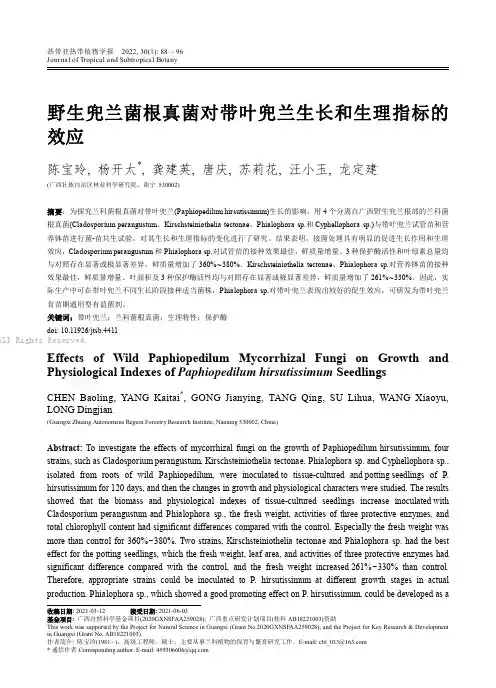
热带亚热带植物学报2022, 30(1): 88 ~ 96Journal of Tropical and Subtropical Botany野生兜兰菌根真菌对带叶兜兰生长和生理指标的效应陈宝玲, 杨开太*, 龚建英, 唐庆, 苏莉花, 汪小玉, 龙定建(广西壮族自治区林业科学研究院,南宁530002)摘要:为探究兰科菌根真菌对带叶兜兰(Paphiopedilum hirsutissimum)生长的影响,用4个分离自广西野生兜兰根部的兰科菌根真菌(Cladosporium perangustum、Kirschsteiniothelia tectonae、Phialophora sp.和Cyphellophora sp.)与带叶兜兰试管苗和营养钵苗进行菌-苗共生试验,对其生长和生理指标的变化进行了研究。
结果表明,接菌处理具有明显的促进生长作用和生理效应,Cladosporium perangustum和Phialophora sp.对试管苗的接种效果最佳,鲜质量增量、3种保护酶活性和叶绿素总量均与对照存在显著或极显著差异,鲜质量增加了360%~380%。
Kirschsteiniothelia tectonae、Phialophora sp.对营养钵苗的接种效果最佳,鲜质量增量、叶面积及3种保护酶活性均与对照存在显著或极显著差异,鲜质量增加了261%~330%。
因此,实际生产中可在带叶兜兰不同生长阶段接种适当菌株,Phialophora sp.对带叶兜兰表现出较好的促生效应,可研发为带叶兜兰育苗期通用型有益菌剂。
关键词:带叶兜兰;兰科菌根真菌;生理特性;保护酶doi: 10.11926/jtsb.4411All Rights Reserved.Effects of Wild Paphiopedilum Mycorrhizal Fungi on Growth andPhysiological Indexes of Paphiopedilum hirsutissimum SeedlingsCHEN Baoling, YANG Kaitai*, GONG Jianying, TANG Qing, SU Lihua, WANG Xiaoyu,LONG Dingjian(Guangxi Zhuang Autonomous Region Forestry Research Institute,Nanning 530002, China)Abstract: To investigate the effects of mycorrhizal fungi on the growth of Paphiopedilum hirsutissimum, fourstrains, such as Cladosporium perangustum, Kirschsteiniothelia tectonae, Phialophora sp. and Cyphellophora sp.,isolated from roots of wild Paphiopedilum, were inoculated to tissue-cultured and potting seedlings of P.hirsutissimum for 120 days, and then the changes in growth and physiological characters were studied. The resultsshowed that the biomass and physiological indexes of tissue-cultured seedlings increase inoculated withCladosporium perangustum and Phialophora sp., the fresh weight, activities of three protective enzymes, andtotal chlorophyll content had significant differences compared with the control. Especially the fresh weight wasmore than control for 360%-380%. Two strains, Kirschsteiniothelia tectonae and Phialophora sp. had the besteffect for the potting seedlings, which the fresh weight, leaf area, and activities of three protective enzymes hadsignificant difference compared with the control, and the fresh weight increased 261%-330% than control.Therefore, appropriate strains could be inoculated to P. hirsutissimum at different growth stages in actualproduction. Phialophora sp., which showed a good promoting effect on P. hirsutissimum, could be developed as a收稿日期: 2021-03-12 接受日期: 2021-06-03基金项目:广西自然科学基金项目(2020GXNSFAA259028); 广西重点研发计划项目(桂科AB18221003)资助This work was supported by the Project for Natural Science in Guangxi (Grant No.2020GXNSFAA259028); and the Project for Key Research & Developmentin Guangxi (Grant No. AB18221003).作者简介: 陈宝玲(1981~ ),高级工程师,硕士,主要从事兰科植物的保育与繁育研究工作。
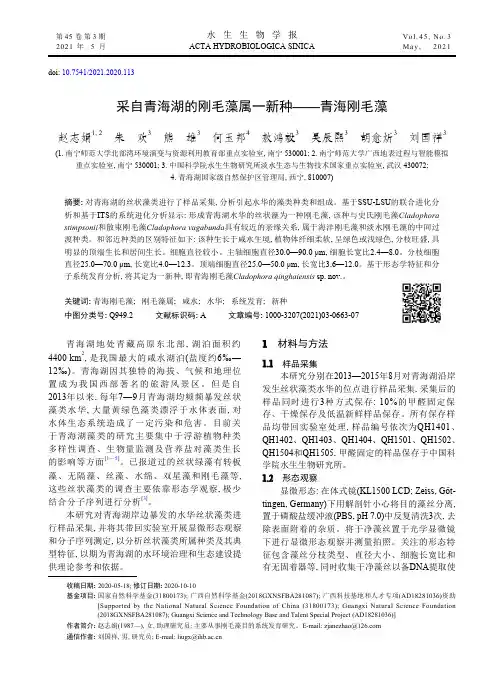
doi: 10.7541/2021.2020.113采自青海湖的刚毛藻属一新种——青海刚毛藻赵志娟1, 2朱 欢3熊 雄3何玉邦4敖鸿毅3吴辰熙3胡愈炘3刘国祥3(1. 南宁师范大学北部湾环境演变与资源利用教育部重点实验室, 南宁 530001; 2. 南宁师范大学广西地表过程与智能模拟重点实验室, 南宁 530001; 3. 中国科学院水生生物研究所淡水生态与生物技术国家重点实验室, 武汉 430072;4. 青海湖国家级自然保护区管理局, 西宁, 810007)摘要: 对青海湖的丝状藻类进行了样品采集, 分析引起水华的藻类种类和组成。
基于SSU-LSU 的联合进化分析和基于ITS 的系统进化分析显示: 形成青海湖水华的丝状藻为一种刚毛藻, 该种与史氏刚毛藻Cladophora stimpsonii 和散束刚毛藻Cladophora vagabunda 具有较近的亲缘关系, 属于海洋刚毛藻和淡水刚毛藻的中间过渡种类。
和邻近种类的区别特征如下: 该种生长于咸水生境, 植物体纤细柔软, 呈绿色或浅绿色, 分枝旺盛, 具明显的顶端生长和居间生长。
细胞直径较小。
主轴细胞直径30.0—90.0 μm, 细胞长宽比2.4—8.0。
分枝细胞直径25.0—70.0 μm, 长宽比4.0—12.3。
顶端细胞直径25.0—50.0 μm, 长宽比3.6—12.0。
基于形态学特征和分子系统发育分析, 将其定为一新种, 即青海刚毛藻Cladophora qinghaiensis sp. nov.。
关键词: 青海刚毛藻; 刚毛藻属; 咸水; 水华; 系统发育; 新种中图分类号: Q949.2 文献标识码: A 文章编号: 1000-3207(2021)03-0663-07青海湖地处青藏高原东北部, 湖泊面积约4400 km 2, 是我国最大的咸水湖泊(盐度约6‰—12‰)。
青海湖因其独特的海拔、气候和地理位置成为我国西部著名的旅游风景区。
Deng & al. • The new genus Zhengyia (Urticaceae)TAXON 62 (1) • February 2013: 89–9989Version of Record (identical to print version).INTRODUCTIONUrticeae (= Urerareae Wedd.) is a moderately sized tribe of the nettle family (Urticaceae) with eleven genera and ap-proximately 220 species. Its members are often found in humid habitats in forests or at forest margins and occur in both the Old and New Worlds (Friis, 1993; Hadiah & al., 2008; Cohn & Hadiah, 2009). The tribe is characterized by stinging hairs and pistillate flowers with four tepals, of which frequently one pair is larger than the other, and without staminodes (Friis, 1989, 1993). Because of the obvious morphological synapo-morphies of Urticeae, it is not difficult to recognize a plant as being a member of this tribe. Moreover, phylogenetic analysis of Urticaceae using plastid DNA sequence data has shown that Urticeae (including Poikilospermum Zipp.) form a well-supported clade (Hadiah & al., 2008).The Shennongjia National Nature Reserve (SNNR) is lo-cated in the Northwest of Hubei province, central China. Its unique geographical location and complex topology make it one of the most biodiverse areas in China (Ying, 2001; Xie, 2003). The Shennongjia Mountains are characterized by high mountains and deep valleys, a dense network of streams, and lush vegetation. The region is an important hot-spot for south-central Chinese biodiversity and contains many endemic plants (Myers & al., 2000). During our recent in-depth floristic ex-plorations of the SNNR, an unusual taxon caught our attention. The plant was easily identified as belonging to Urticeae based on the presence of stinging hairs, stipules, and pistillate flow-ers with four tepals and without staminodes. In its paniculate inflorescences with many long branches and its four-lobed perianth with larger dorsal than ventral lobes in its female flowers, it superficially resembles Urtica L., a genus of about 30 species with a wide distribution in the northern temperate region (Chen & al., 2003). However, based on its alternate leaf arrangement, the presence of one to three woody bulbils in sterile axils, intrapetiolar stipules in the leaf axils, and oblique achenes with short stipes, we initially assigned the new taxon to Laportea Gaudich., a genus with 30 species confined to tropical and warm-temperate E Asia and eastern North America (Friis, 1993). Upon closer examination, however, it was clear that the set of morphological characters did not match Urtica, Laportea or any other genus of Urticeae (Table 1). The plant is described below as a new genus with only one species, Zhengyia shen-nongensis T. Deng, D.G. Zhang & H. Sun.Bulbils are specialized propagules, allowing vegetative reproduction and dispersal, and many herbaceous plants can produce them (Wang & al., 2004; Walck & al., 2010). Pres-ence or absence of bulbils has been recognized as a significant
Zhengyia shennongensis: A new bulbiliferous genus and species of the nettle family (Urticaceae) from central China exhibiting parallel evolution of the bulbil trait
Tao Deng,1,2,5 Changkyun Kim,1,5 Dai-Gui Zhang,3 Jian-Wen Zhang,1 Zhi-Ming Li,4 Ze-Long Nie1 & Hang Sun11 Key Laboratory of Biodiversity and Biogeography, Kunming Institute of Botany, Chinese Academy of Sciences, Kunming 650201, Yunnan, P.R. China2 University of Chinese Academy of Sciences, Beijing 100039, P.R. China3 Key Laboratory of Plant Resources Conservation and Utilization, Jishou University, College of Hunan Province, Jishou 416000, Hunan, P.R. China4 Life Science School, Yunnan Normal University, Kunming 650031, Yunnan, P.R. China5 These authors contributed equally to the work.Author for correspondence: Hang Sun, hsun@mail.kib.ac.cn
Abstract Zhengyia shennongensis is described here as a new genus and species of the nettle family (Urticaceae) from Hubei province, central China. The phylogenetic position of Z. shennongensis is determined using DNA sequences of nuclear ribo-somal ITS and three plastid regions (rbcL, psbA-trnH, trnL-F). Zhengyia shennongensis is readily distinguished from the related genera Urtica, Hesperocnide, and Laportea in the tribe Urticeae by its seed (oblong-globose or subglobose and not compressed achenes, surface densely covered with nipple-shaped protuberances) and stipule morphology (large leaf-like stipules with auriculate and amplexicaulous base and united with stem). Phylogenetic evidence indicates that Zhengyia is a distinct group related to Urtica (including Hesperocnide) species and Laportea cuspidata in tribe Urticeae. The bulbiliferous species of the tribe (L. bulbifera, L. cuspidata, Z. shennongensis) do not form a clade. This result indicates that the bulbil trait evolved in parallel within Urticeae. Our findings highlight the importance of shady and moist habitats in promoting species diversification and the parallel evolution of morphological traits that are likely to be adaptive.